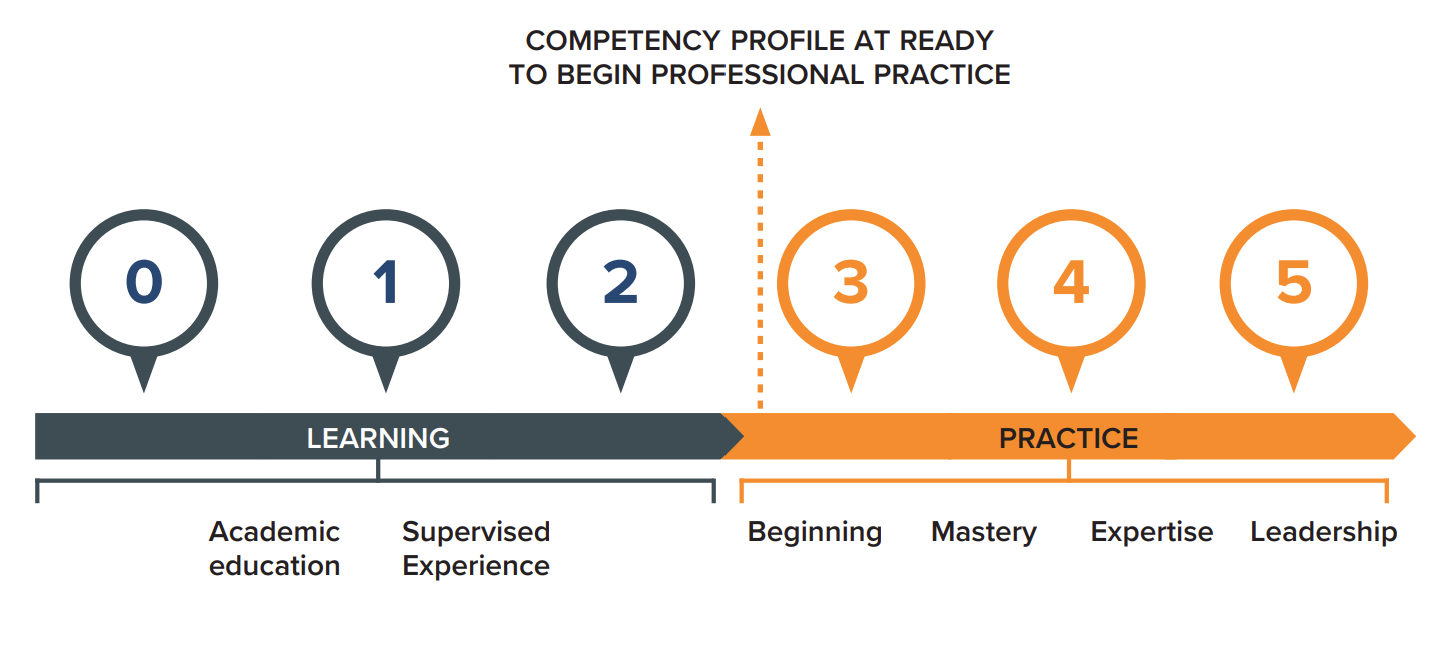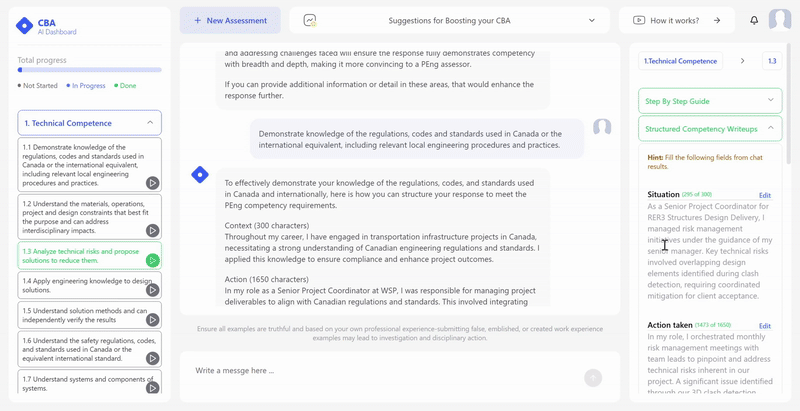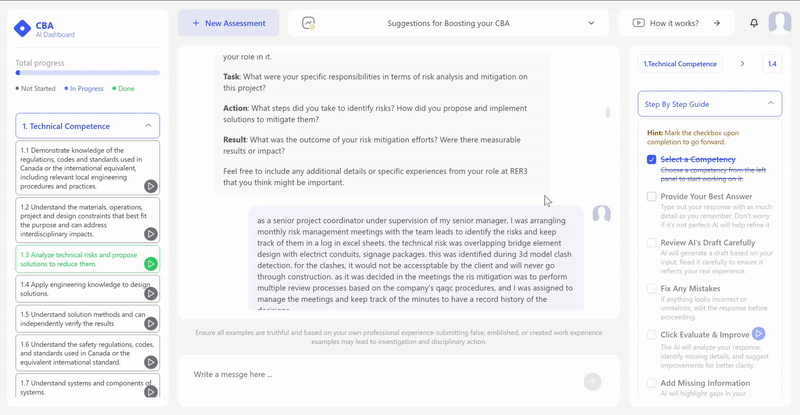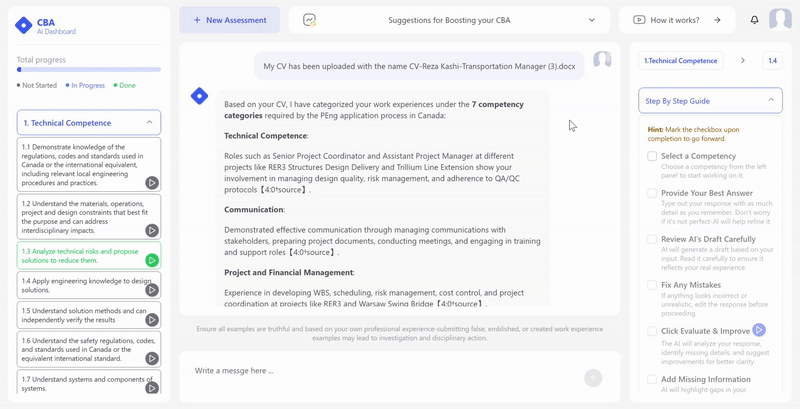Whether you’re an internationally trained engineer or a recent Canadian graduate, one thing is clear—navigating the CBA scoring scale is key to your journey toward obtaining your P.Eng. license. The Competency-Based Assessment (CBA) is not just about listing your years of experience; it’s about proving that you can do the job—consistently, safely, and professionally. And the scoring scale is where your readiness gets officially measured.
PEO and other Canadian engineering regulators have adopted a structured 0–5 rating system to assess your demonstration of 34 essential engineering competencies. These competencies span everything from technical design to professional ethics and team collaboration. To succeed, you need to understand not only how you’re rated but also how these ratings translate into your eligibility to practice engineering independently.
In this blog, we’ll break down how the CBA scoring scale works and how CBA Pro helps you with this step of your process—what each score really means, who assigns these scores, and what minimum levels you must meet across different categories. By the end, you’ll know how to interpret your scores, improve your submissions, and confidently move one step closer to that coveted P.Eng. title.
The main reference for this blog is the CBA Applicant Guide from PEO.
Understanding the CBA Scoring Scale
At the heart of the CBA scoring scale lies a simple 0-to-5 rating system—but behind each digit is a detailed picture of your professional readiness. When you submit your Competency-Based Assessment, assessors from PEO evaluate each of your 34 competency responses using this scale, determining not just what you’ve done, but how independently and proficiently you’ve performed engineering tasks.

Here’s how the scale breaks down:
-
0 – No exposure: You have no experience in the competency area.
-
1 – Limited exposure: You have observed or minimally contributed to the competency.
-
2 – Assisted: You’ve applied the competency with supervision or guidance.
-
3 – Performed independently: You’re able to work unsupervised in that area—this is the baseline for licensure.
-
4 – Mastery: You’ve consistently performed the task and mentored others.
-
5 – Leadership: You lead teams or influence strategic decisions in the competency area.
Sounds a bit abstract? That’s where CBA Pro can save you hours of confusion. The tool provides AI-driven explanations and smart feedback on how your example aligns with each level on the rating scale to guide CBA self assessment. For instance, if your description sounds like level 2 rather than level 3, CBA Pro flags it—and even suggests edits to help elevate your response to meet the minimum standards.

But scoring isn’t just about individual competencies. Assessors also calculate category averages. Each of the seven CBA categories—such as Technical Competence or Professional Accountability—has a required average rating, often a 2 or 3. Even if you meet the minimum score for each individual competency, falling short on the category average can delay your licensure. With CBA Pro’s category-level analysis, you’ll know in advance where your submission might be falling short—and how to fix it before submission.
Minimum Score Requirements Across Competency Categories
Understanding how individual competency ratings work is just the beginning. What often catches applicants off guard is the minimum score requirement per category—a vital piece of the CBA scoring scale puzzle. PEO doesn’t just want you to show competence here and there; they need to see that you’re consistently proficient across all seven categories of engineering practice.
Each category, such as Technical Competence or Communication, includes several specific competencies. While most competencies require a minimum individual score of 1, professional standards competencies (like safety, ethics, and quality management) demand a minimum of 2 or even 3. Here’s a quick snapshot:
-
Technical Competence: Min. average 3
-
Communication: Min. average 3
-
Project & Financial Management: Min. average 2
-
Team Effectiveness: Min. average 3
-
Professional Accountability: Min. average 3
-
Social, Environmental, Economic & Sustainability: Min. average 2
-
Continuing Professional Development: Min. average 3
Missing just one rating—especially in a professional standards area—can mean rework, resubmission, or worse, delays in your licensure process. But here’s where CBA Pro proves invaluable. With its smart analytics, it calculates your projected category averages in real time, giving you an instant heads-up if any category is lagging. No need to guess whether you’ve hit the mark—CBA Pro shows you where you stand and what actions to take before you ever press submit.
It’s also worth noting that the assessors have the final say, but your validators’ scores and your self-assessments are considered as supporting insight. With CBA Pro’s validator coordination tracker, you can ensure each competency has been reviewed by the right person, and all ratings are aligned—so your package lands with clarity and credibility.
Strategies for Achieving Target Scores
If you want to succeed with the CBA scoring scale, you need more than just experience—you need strategy. Scoring a 3 or higher means proving you’ve worked independently, exercised professional judgment, and applied engineering principles in real-world contexts. So how do you get there?
1. Use the Situation-Action-Outcome (SAO) Framework
This is non-negotiable. Each work example you submit should clearly outline:
-
Situation: What was the context or problem?
-
Action: What did you do (not your team)?
-
Outcome: What was the result, and how did it show competence?
The biggest mistake applicants make is writing vague or team-focused narratives. Assessors want to know exactly what you did. Here’s where CBA Pro shines: it helps you structure your stories with guided SAO templates and even evaluates if your “Action” section demonstrates the level of independence required for a score of 3 or above.

2. Match Your Example to the Right Competency
Don’t try to force-fit your experience. Choose examples that directly align with the indicators under each competency. For instance, if you’re submitting for “Technical Risk Management,” but your example doesn’t show how you identified or mitigated risk—you’re setting yourself up for a lower score.
CBA Pro’s smart matching engine can analyze your draft examples and suggest which competencies they best align with. This eliminates the guesswork and ensures you’re putting your best foot forward in each submission.

3. Fill in the Gaps Before You Submit
Many applicants fail to meet the category average because they unintentionally leave gaps. Maybe one competency is too weak, or you skipped one entirely. Before that happens, use CBA Pro’s gap analysis dashboard, which shows you exactly:
-
Which competencies are below target
-
Which categories are at risk of failing average
-
Which examples could be strengthened with specific engineering indicators
Instead of revising blindly, you’ll revise strategically—saving time, effort, and potential rejection.
Common Pitfalls and How to Avoid Them
The CBA scoring scale doesn’t just test your experience—it reveals how well you understand and communicate that experience. Many applicants get tripped up not because they lack the skills, but because they fail to present them effectively. If you want to pass on the first try, steer clear of these common traps.
1. Vague or Team-Based Work Examples
One of the top reasons applicants get low scores is using team-centric language. Phrases like “we decided” or “our team implemented” make it impossible for assessors to determine your individual role. Remember: CBA is about your competence, not your team’s.
Pro Tip with CBA Pro: Its smart review system highlights vague phrasing and prompts you to reframe sentences to reflect your specific actions and decisions—essential to achieving a score of 3 or higher.
2. Misunderstanding the Rating Criteria
Applicants often aim to “just meet the requirement” but don’t understand that scoring a 3 means performing without supervision. A detailed technical story might only score a 2 if it’s clear your supervisor guided the entire process. That’s a costly miss.
CBA Pro includes in-app guidance on what a level 3, 4, or 5 example actually looks like—tailored to each competency. You’ll know exactly what to demonstrate and where your current example falls short.
3. Overlooking Professional Standards Competencies
These six competencies have stricter minimums—typically a 2 or 3. But many applicants treat them like any other competency and fail to hit the required depth. Topics like safety, ethics, and codes require not just familiarity but actual application in your work.
With CBA Pro’s Standards Tracker, you get clear visual feedback on which professional standards you’ve covered, where your examples might be too shallow, and how to bring them up to par before you submit.
By catching these issues early, you can avoid the frustration of a failed assessment or months of revision cycles. Let CBA Pro be your checkpoint before PEO becomes your gatekeeper.
Conclusion: Master the CBA Scoring Scale, Own Your P.Eng. Journey
The CBA scoring scale isn’t just a numbers game—it’s a reflection of your readiness to practice engineering independently and ethically in Canada. From scoring a 3 in technical design to meeting category averages and nailing professional standards competencies, every rating you receive is a signal of your strength—or a cue to improve.
But here’s the truth: most applicants don’t fail because they lack the skills—they stumble because they don’t know how to frame their experience in a way that speaks the assessor’s language. That’s where CBA Pro makes all the difference. It’s more than a tool—it’s a strategic partner that helps you organize, evaluate, and enhance your application in real time.
Whether you’re just starting out or revising after a setback, don’t leave your P.Eng. future to guesswork. Use CBA Pro to analyze your ratings, identify your gaps, and confidently submit a complete application that checks every box—and scores every point.
Ready to take control of your CBA application and start scoring like a pro?
Complete our quick intake form to get started with CBA Pro today and get personalized support on your path to licensure.


